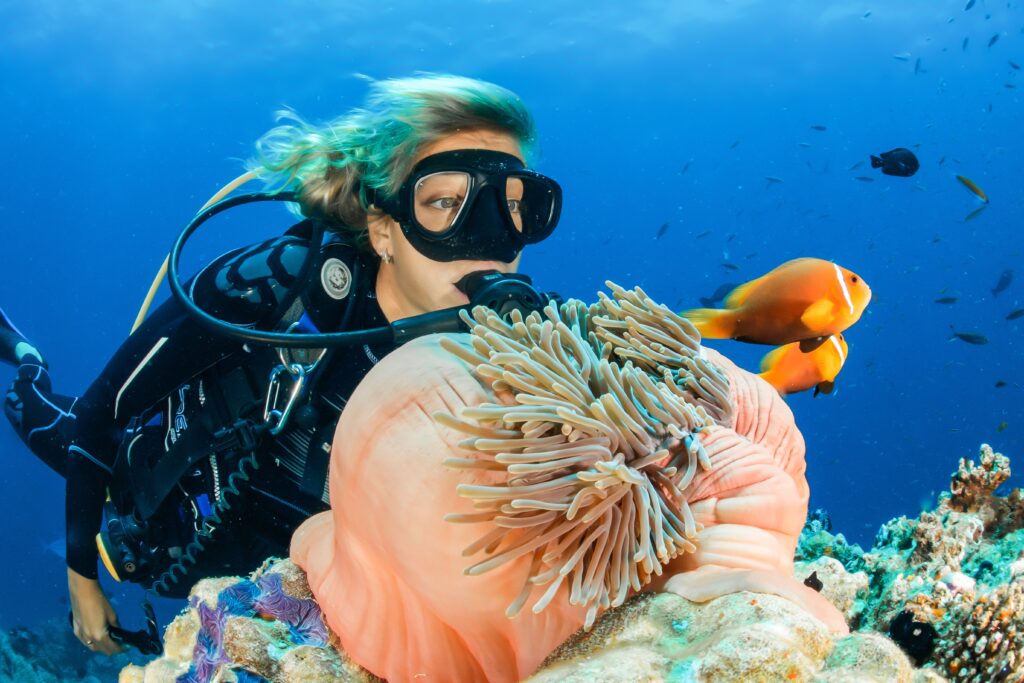by MARSHALL BONE
The growing world of underwater painting gives artists another set of mediums and artistic freedom. While this isn’t a new artistic practice by any means – the first recorded instance of successful underwater painting was painted by Eugen von Ransonnet in 1867 – it has been growing in popularity as snorkeling and scuba gear become more widely available.
While von Ransonnet did not have scuba or snorkel gear, his painting was indeed completed fully underwater through a weighted glass container that was sunk underwater and filled with air from a tube connected to the surface.
Olga Nikitina is a Russian painter living in Egypt whose main artistic outlet is scuba diving into the Red Sea and painting scenes from the coral reefs there. She says the most important thing to her is that the paint she uses doesn’t leech into the water while she paints. She uses a specially designed canvas and non-water-soluble, non-toxic oil paint that sticks to her canvas without melting into the sea around her.
How to Get Started with Underwater Painting
Getting started with underwater painting isn’t difficult. While there isn’t a set of standard practices to start, the main thing is to connect with other underwater artists to see what works for them and tailor that to your style.
Gear Up
The first step to safely starting your new hobby is to get yourself appropriate and high-quality swim gear. If you’re going to be painting underwater, you’re going to be in the water for long stretches of time, and you can’t buy just any old swimsuits from a chain retailer. High-quality swim gear made for competitive swimmers will stand the test of time and hold up for much longer, especially in salt water. You’ll also need some large goggles or a snorkel mask. If you’re in deeper water, you’ll probably be using a wet suit and a scuba mask, so it’s in your best interests to research the types of gear that other underwater painters use. While you’ll also need to find your preferred brand of non-water-soluble paint, a good waterproof pen might be a smart investment, too- to take notes or to make your beginning sketches.
Start Training
Getting yourself into a good cardiovascular health routine before spending hours on the seafloor strapped to an oxygen tank is definitely a good idea. Running, cycling, dancing, or taking cardio-heavy classes regularly can help you get into tip-top shape for diving and painting.
Get Used to Wearing Heavy Gear
If you’re not a practiced scuba diver, getting used to strapping yourself into the heavy and cumbersome scuba gear can feel claustrophobic and difficult. If you’re a motorcyclist or know someone who is, trying on some motorcycle gear can be a great way to get used to the feeling of the gear you’ll be wearing in the water as you paint.
 Where Should I Go To Underwater Paint?
Where Should I Go To Underwater Paint?
This is where your preferences and personality can make a huge difference in what you end up painting- and where you go to do it. If you’re just doing underwater painting as a one-off on vacation in Isla Mujeres, for example, your paintings are likely going to be brilliantly colored tropical fish, coral, and life forms. Freshwater lakes and rivers are going to present a different underwater painting challenge, as well as different subjects, textures, and backgrounds.
If you’re looking to stay a little closer to home and find opportunities to paint in nature areas near you, you may not need as much heavy gear, especially during seasonal warm weather. If the water you’re painting in is warm and clear, all you need is your good swimsuit and a good snorkel mask so you can see your canvas.
Refining Technique
If you’re worried about your technique as an artist, or underwater painting is the first time you’ve tried painting at all, refining your technique is a great way to feel more successful and fulfilled in your hard work. Do some research on painting styles and techniques that famous artists use, and ask yourself some questions about art. Which artists inspired you to start making art? What great paintings do you love, and what specifically about them makes you excited? Find these special things and try to incorporate them into your painting style.
Find the artists in your community and try to work with them or watch them work. Even if they aren’t painters, watching their process can help spark ideas for your paintings. Connect with people in your community who also care about the underwater world, and see if you can glean some of their knowledge to make your painting scenes and experiences richer and more varied.







